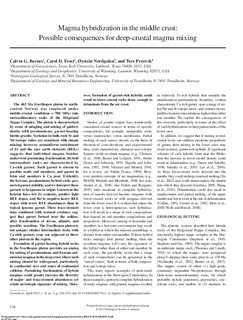| dc.contributor.author | Barnes, CG | |
| dc.contributor.author | Frost, CD | |
| dc.contributor.author | Nordgulen, Øystein | |
| dc.contributor.author | Prestvik, Tore | |
| dc.date.accessioned | 2019-10-15T06:15:48Z | |
| dc.date.available | 2019-10-15T06:15:48Z | |
| dc.date.created | 2012-09-20T09:05:41Z | |
| dc.date.issued | 2012 | |
| dc.identifier.citation | Geosphere. 2012, 8 (2), 518-533. | nb_NO |
| dc.identifier.issn | 1553-040X | |
| dc.identifier.uri | http://hdl.handle.net/11250/2622094 | |
| dc.description.abstract | The 465 Ma Svarthopen pluton in north-central Norway was emplaced under middle-crustal conditions (∼700 MPa) into metasedimentary rocks of the Helgeland Nappe Complex. The pluton is characterized by zones of mingling and mixing of gabbro/diorite with peraluminous, garnet-bearing biotite granite. Variation in bulk-rock Sr and Nd isotope ratios are consistent with simple mixing; however, nonuniform enrichment of Zr and the rare earth elements (REEs) suggests that individual magma batches underwent postmixing fractionation. Hybrid intermediate rocks are characterized by Carich garnet. Such garnet is absent in possible mafic end members, and garnet in felsic end members is Ca poor. Evidently, the ferroan, peraluminous hybrid rocks promoted garnet stability, and we interpret these garnets to be igneous in origin. Garnets in the hybrids have low Zr contents, positive light REE slopes, and flat to negative heavy REE slopes with lower REE abundances than in typical igneous garnet. These trace-element data combined with textural evidence suggest that garnet formed near the solidus, after fractionation of zircon, allanite, and possibly xenotime. The Svarthopen pluton is not unique: similar intermediate rocks with Ca-rich garnets crop out adjacent to three other plutons in the region.
Formation of garnet-bearing hybrid rocks in the Svarthopen pluton provides an analog for mixing of peraluminous and ferroan end-member magmas in the deep crust, where such mixing should be widespread, particularly in continental arcs and zones of continental collision. Postmixing fractionation of hybrid magmas could greatly increase the diversity of major- and trace-element abundances yet retain an isotopic signature of mixing. Moreover, formation of garnet-rich hybrids could result in lower-crustal rocks dense enough to delaminate from the arc crust. | nb_NO |
| dc.language.iso | eng | nb_NO |
| dc.publisher | The Geological Society of America, GSA | nb_NO |
| dc.rights | Navngivelse-Ikkekommersiell 4.0 Internasjonal | * |
| dc.rights.uri | http://creativecommons.org/licenses/by-nc/4.0/deed.no | * |
| dc.title | Magma hybridization in the middle crust: Possible consequences for deep-crustal magma mixing | nb_NO |
| dc.type | Journal article | nb_NO |
| dc.type | Peer reviewed | nb_NO |
| dc.description.version | publishedVersion | nb_NO |
| dc.source.pagenumber | 518-533 | nb_NO |
| dc.source.volume | 8 | nb_NO |
| dc.source.journal | Geosphere | nb_NO |
| dc.source.issue | 2 | nb_NO |
| dc.identifier.doi | 10.1130/GES00730.1 | |
| dc.identifier.cristin | 945149 | |
| dc.description.localcode | Open Access CC-BY-NC | nb_NO |
| cristin.unitcode | 194,64,90,0 | |
| cristin.unitname | Institutt for geovitenskap og petroleum | |
| cristin.ispublished | true | |
| cristin.fulltext | original | |
| cristin.qualitycode | 1 | |

